It has received large shipments of rockets and drones from Iran, its principal patron, and has more recently begun to produce its own weapons. The group also boasts air defense capabilities, which most militias don’t have.
Hezbollah’s known rocket and missiles
Max. range (in miles)
Reported attacks since Oct. 7
Incidents include airstrikes and
shelling, as well as drone, artillery
and missile attacks.
Note: The Golan Heights were seized by Israel in 1967
and illegally annexed in 1981.
Source: ACLED. Data as of June 28
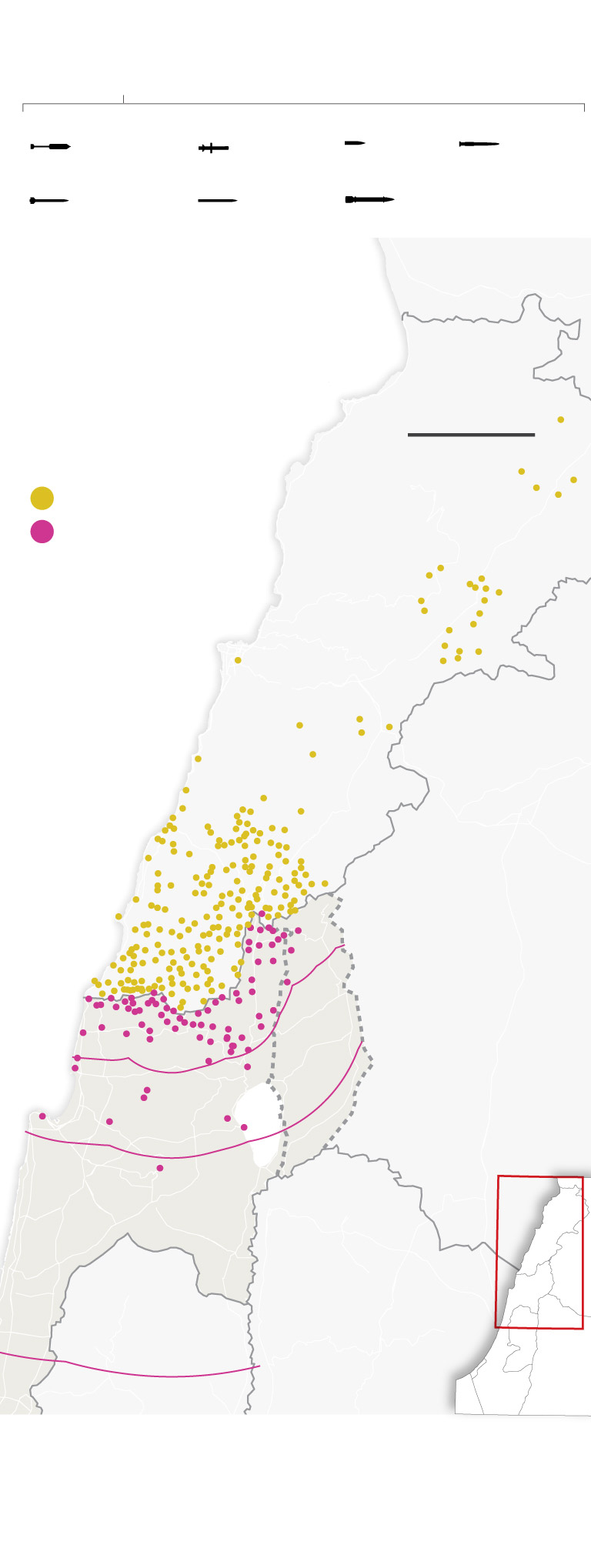
Hezbollah’s known rocket and missiles
Max. range (in miles)
Reported attacks since Oct. 7
Incidents include airstrikes and
shelling, as well as drone, artillery
and missile attacks.
Note: The Golan Heights were seized by Israel in 1967
and illegally annexed in 1981.
Source: ACLED. Data as of June 28
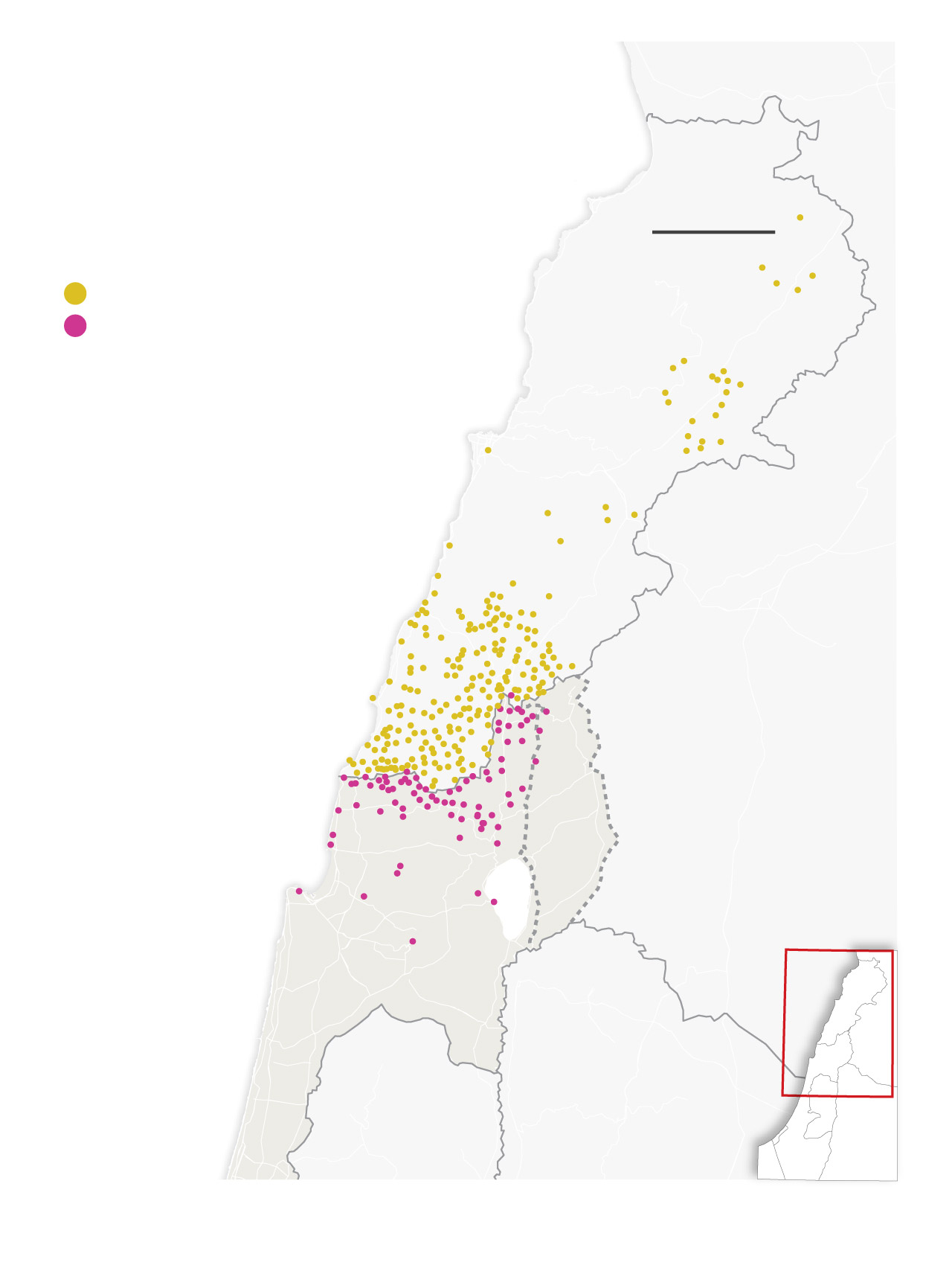
Reported attacks since Oct. 7
Incidents include airstrikes and
shelling, as well as drone, artillery
and missile attacks.
( Annexed by Israel
in 1981. Not internationally
recognized.)
Source: ACLED. Data as of June 28
The group’s arsenal includes guided and unguided rockets, antitank artillery, ballistic and anti-ship missiles, as well as explosives-laden drones — portending a complex, multi-front conflict that could reach far into Israeli territory.
Analysts estimate Hezbollah has between 130,000 and 150,000 rockets and missiles, more than four times as many as its ally Hamas was believed to have stockpiled before the war in Gaza. And the Lebanese group says it commands more than 100,000 soldiers, well over double the high-end estimates of Hamas’s prewar fighting force.
Most of Hezbollah’s weapons are lower-grade, unguided munitions, which could threaten Israel’s aerial defense systems if unleashed in large numbers. Even more concerning for Israel are precision munitions the group has said it possesses.
Hezbollah keeps a tight lid on its arsenal, leaving weapons experts to guess about the full extent of its capabilities. Much of what is publicly known comes from statements by the group, and its leader, Hasan Nasrallah, who says his fighters have only used “a portion of our weapons” in escalating attacks on northern Israel since Oct. 8.
Israel’s military has retaliated with intense strikes on Lebanon, mostly in the south, using fighter jets, tanks, Hermes drones and white phosphorus munitions.
Tens of thousands of civilians have been displaced on both sides of the border.
At least 94 civilians and more than 300 Hezbollah fighters have been killed in Israeli strikes in Lebanon, according to figures compiled by The Washington Post. The attacks have caused $1.5 billion in damages and have destroyed around 1,700 buildings, the Lebanese government estimates.
Israeli officials say Hezbollah attacks have killed 20 soldiers and 12 civilians. They have also damaged hundreds of homes and ignited fires that burned more than 40,000 acres.
Hezbollah first started hitting northern Israel a day after Hamas-led militants stormed the country, killing some 1,200 people and taking more than 250 hostages. The group has said it will continue fighting until Israel agrees to a cease-fire in Gaza.
Hezbollah has used different short-range missiles and rockets, at first targeting tanks and other technical equipment near the border before progressing to attacks on military barracks and bases.
On Nov. 11, Nasrallah revealed Hezbollah was using Burkan rockets. An improvised rocket-assisted munition that can be easily assembled, the Burkan has become a “signature weapon of Iran-supported groups in the region,” according to Fabian Hinz, a defense and military analyst at the International Institute for Strategic Studies.


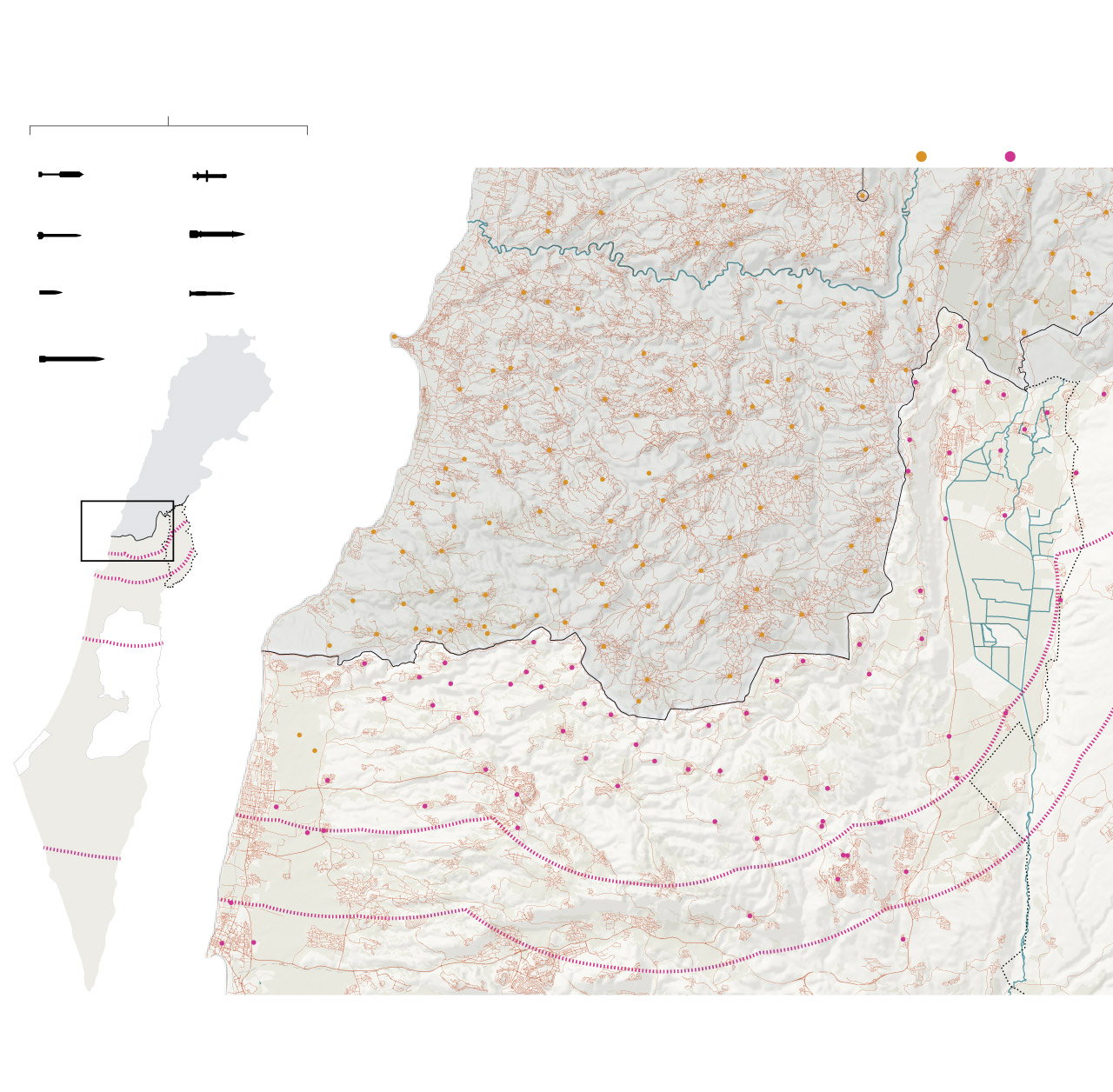
Hezbollah’s known
rocket and missiles
Max. range (in miles)
Attacks reported since Oct. 7
Note: The Golan Heights were seized by Israel in 1967 and illegally annexed in 1981.
Source: ACLED. Data as of June 28
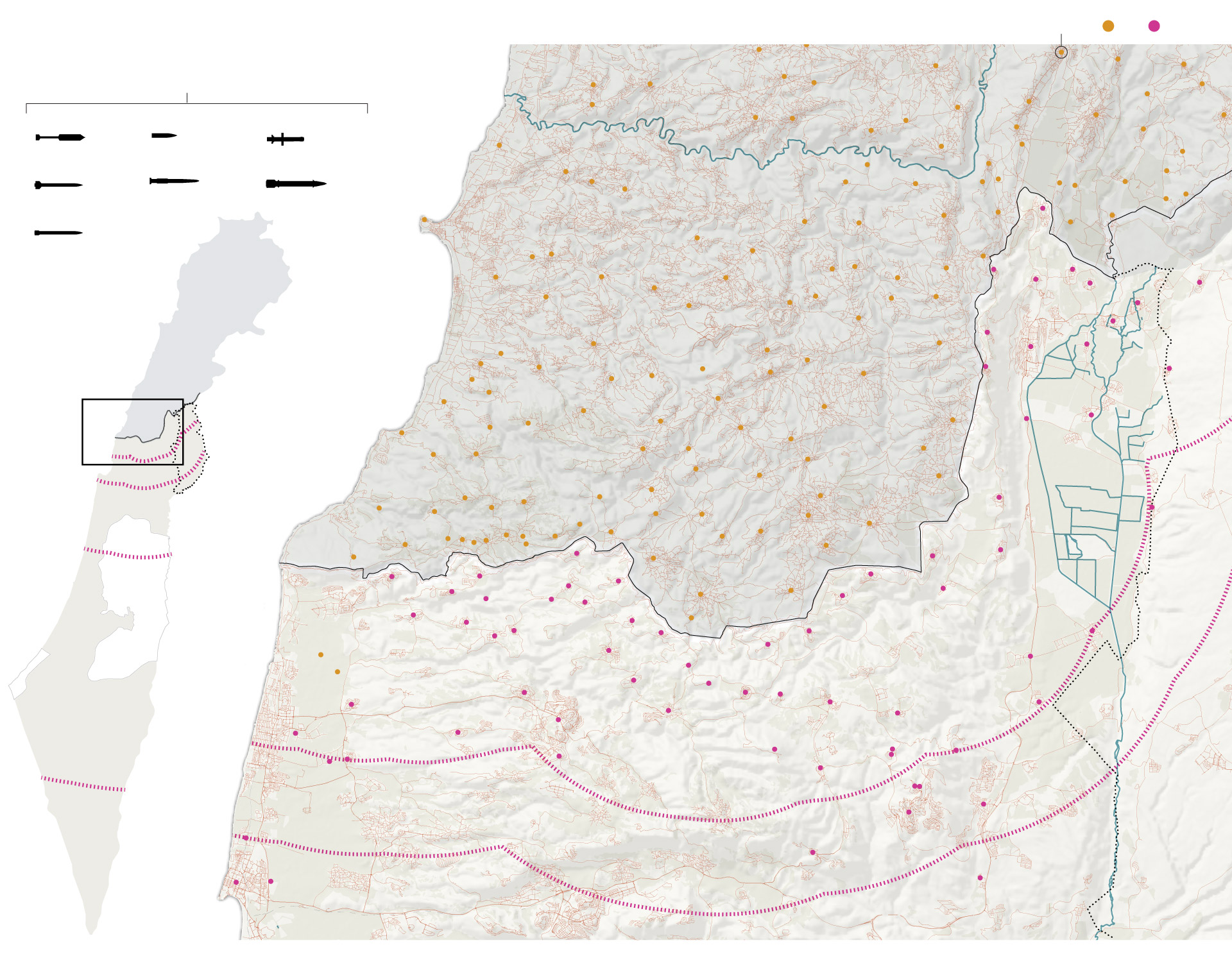
Attacks reported since Oct. 7
Hezbollah’s known rocket and missiles
Max. range (in miles)
Source: ACLED. Data as of June 28
Note: The Golan Heights were seized by Israel in 1967 and illegally annexed in 1981.
The Alma Research and Education Center, an Israeli think tank, says the weapon can be fired from a ground launcher and can cause “extensive destruction” up to 500 feet from the point of impact.
Gen. Mounir Shehadeh, a former Lebanese government coordinator to the U.N. peacekeeping mission in Lebanon, said the Burkan was first used and tested by Hezbollah in Syria — where Nasrallah deployed fighters to prop up President Bashar al-Assad during the country’s civil war.
Nasrallah also revealed in November that the group was using Katyusha rockets. Originally made by the Soviet Union and copied by Iran, they can travel 12 to 24 miles and are fired in a series.
Although they are unguided, Hinz says Hezbollah “can fire lots of them because they are cheap and, until certain ranges, they work.”
In an interview with Hezbollah’s Al-Manar TV in early July, an artillery officer, identified as Hajj Muhammad Ali, speaking with his face blurred and voice altered, said the group is capable of firing 100 Katyushas at a time from truck-mounted launchers.
Iranian-made Raad rockets were used by Hezbollah in a deadly attack on the Israeli port city of Haifa during the 2006 war, but have not been unleashed yet during this round of fighting.
In January, after Israel killed top commander Wissam Tawil, Hezbollah started showcasing more sophisticated rockets, including the Iranian-made Falaq model. This was followed by camera-equipped Almas weapons, guided antitank missiles that can pierce heavy armor.
Larger guided ballistic missiles, like the Fateh 110, present a greater threat, with a range of up to 185 miles, potentially putting Tel Aviv, and even Jerusalem, in the crosshairs. Similar missiles were used by Iran in an unprecedented — but well-telegraphed — aerial attack against Israel earlier this year, giving the Israeli military time to intercept them. It’s unclear what impact they might have if launched from across the border in Lebanon, especially in large numbers.
Nasrallah said in 2018 that Hezbollah possesses precision-guided munitions (PGMs), but the group has never tested or showcased them in public. More recently, in 2022, he claimed Hezbollah has the ability to “transform our rockets … into precision missiles” with the help of Iranian experts.
Analysts say he could be referring to something like the Spice kits the United States provides to Israel to retrofit “dumb bombs” into precision munitions.
PGMs are more effective because they “they’re equipped with active seekers,” said Shaan Shaikh, a fellow at the Center for Strategic and International Studies and deputy director of its Missile Defense Project.
“Nasrallah has talked about it, the [Israel Defense Forces] has raised concerns. … But it’s hard to say anything definitive without proof,” he added.

Some of Hezbollah’s known
missiles and rockets
Short-range ballistic missile
Note: Illustrations are based in low resolution images and are
for illustrative purposes only. Not to scale.
Sources: Hezbollah official statements, CSIS,
Army Recognition, Cat-Uxo

Some of Hezbollah’s known
missiles and rockets
Short-range ballistic missile
Note: Illustrations are based in low resolution images and are
for illustrative purposes only. Not to scale.
Sources: Hezbollah official statements, CSIS,
Army Recognition, Cat-Uxo
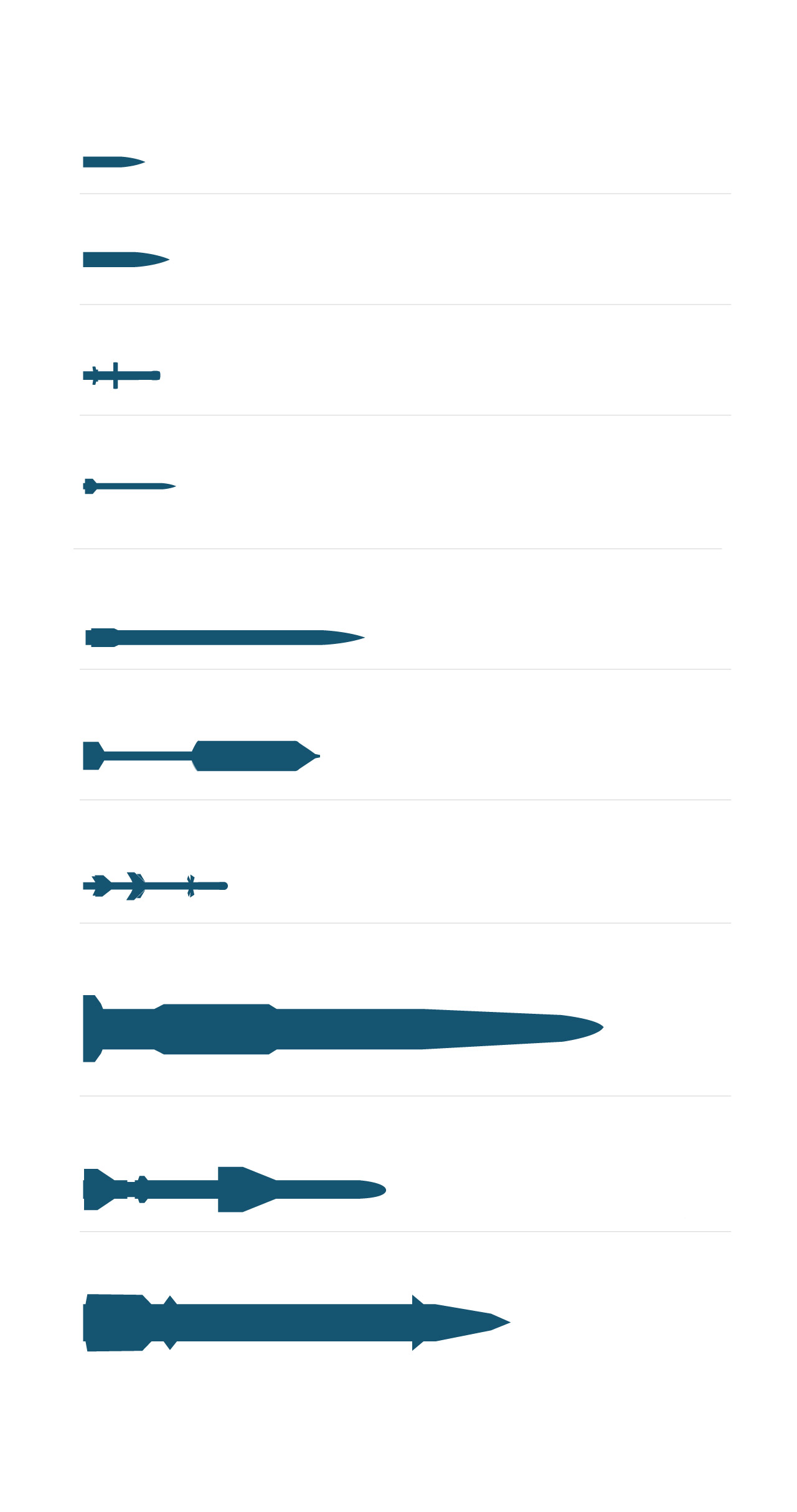
Some of Hezbollah’s known missiles and rockets
Short-range ballistic missile
Note: Illustrations are based in low resolution images and are
for illustrative purposes only. Not to scale.
Sources: Hezbollah official statements, CSIS, Army Recognition, Cat-Uxo
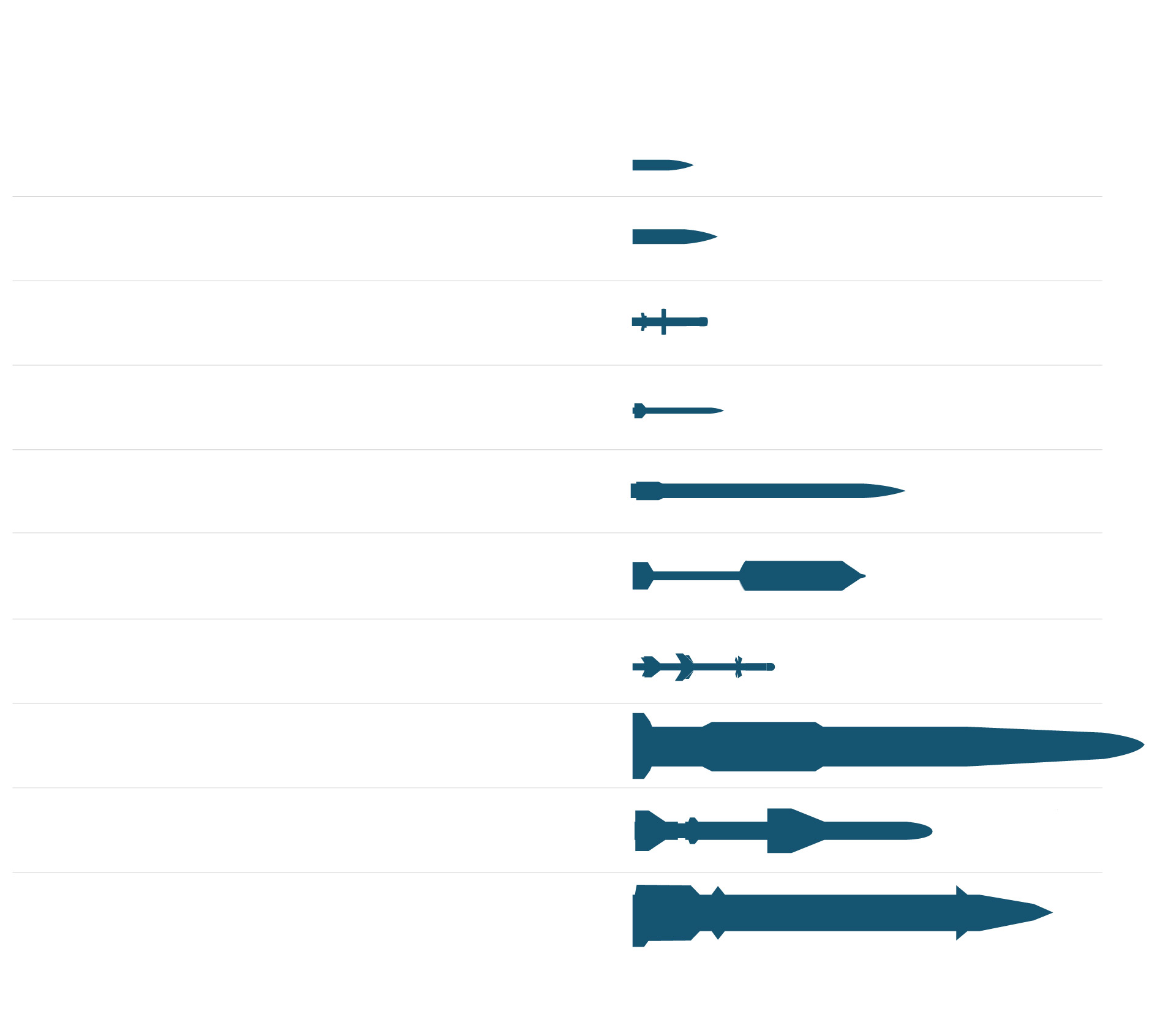
Some of Hezbollah’s known missiles and rockets
Short-range ballistic missile
Note: Illustrations are based in low resolution images and are for illustrative purposes only. Not to scale.
Sources: Hezbollah official statements, CSIS, Army Recognition, Cat-Uxo
Hezbollah is secretive about its arsenal, Hinz said. It took 13 years for the group to reveal that it used a C-802 missile to sink an Israeli ship in 2006.
Anti-ship missiles could also be used to hit offshore oil rigs, specifically in Israel’s Leviathan gas field — a target the group alluded to in a video last month.
Hezbollah has a large fleet of drones at its disposal, varying in size, shape and capability.
According to official statements, the group first started using explosive-laden drones on Nov. 2 in an attack on an Israeli army post in the Golan Heights, footage of which was later released on its Telegram account. The IDF said two soldiers were injured.
Hinz says the type of drone used in this and other attacks were most likely modeled after the Iranian Ababil-T drone, which the Alma Research and Education Center says can travel about 75 miles with nearly 90 pounds of explosives.
In mid-May, after Israeli forces invaded Rafah, in southern Gaza, Hezbollah unleashed a more advanced version that can fire two rockets and explode upon impact. The unmanned aerial vehicle was first used in a May 16 attack on an Israeli army garrison near the border, which injured three soldiers, the IDF said.

Some of the drones believed
to be used by Hezbollah
Range
Max. speed
Max. ceiling
74.5 miles
190 mph
9,800 ft.
It can be equipped
with 88 pounds of explosives.
A video published by Hezbollah
on May 16 indicated that two S5 rockets
were fired from pipes fitted on the UAV’s wings.
Distance
Max. speed
Flight time
Max ceiling
11.2 miles
44.7 mph
31 min.
19,685 ft.
Max. speed
Flight time
Max. ceiling
45 mph
30 min.
19,685 ft.
Note: Illustrations are based in low resolution images and are for illustrative purposes only.
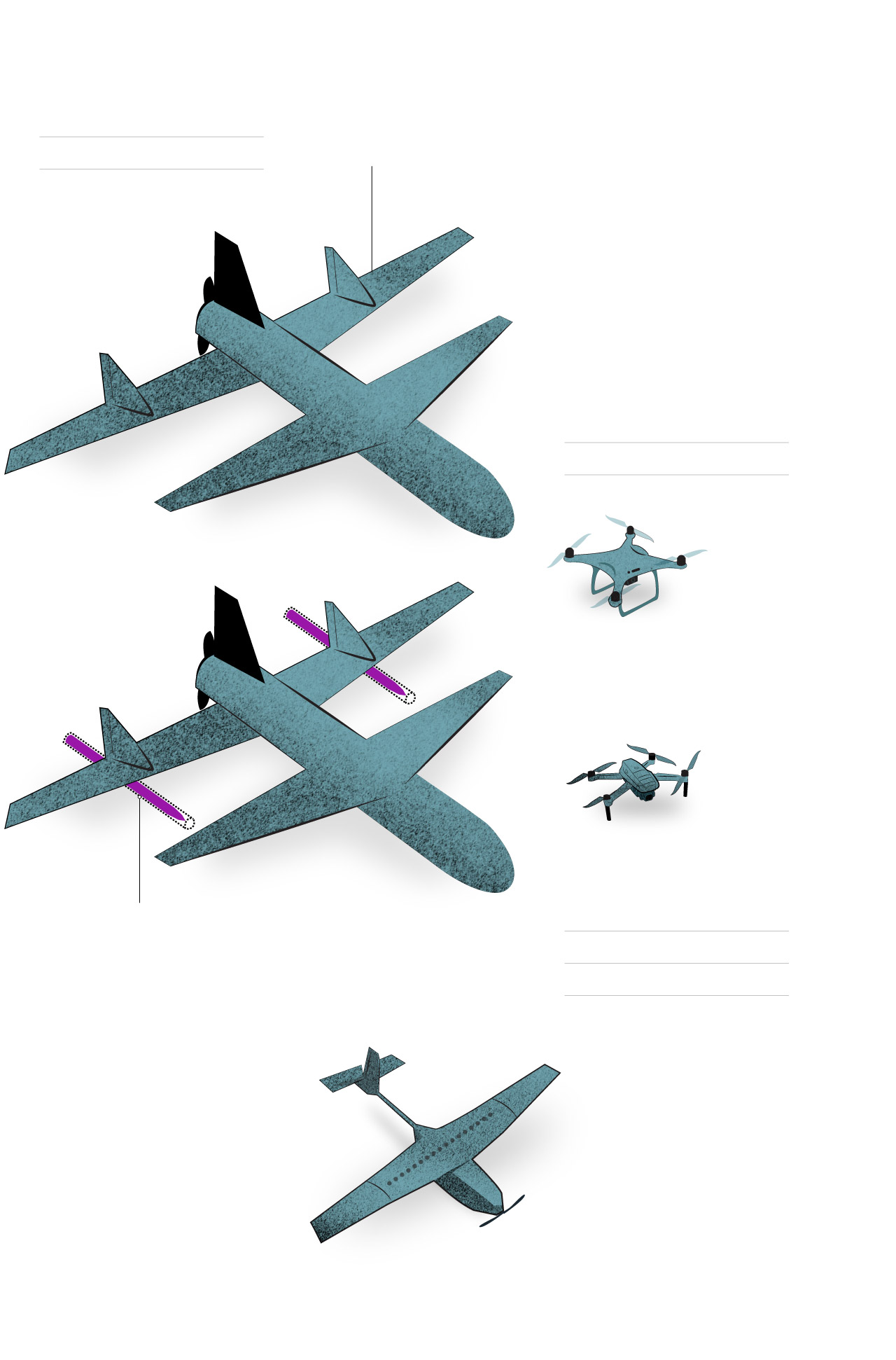
Some of the drones believed to be used by Hezbollah
Range
Max. speed
Max. ceiling
74.5 miles
190 mph
9,800 ft.
It can be equipped
with 88 pounds of explosives.
Max. speed
Flight time
Max. ceiling
45 mph
30 min.
19,685 ft.
Distance
Max. speed
Flight time
Max ceiling
11.2 miles
44.7 mph
31 min.
19,685 ft.
A video published
by Hezbollah on May 16
indicated that two S5 rockets
were fired from pipes fitted
on the UAV’s wings
Note: Illustrations are based in low resolution images and are for illustrative purposes only.
Although Iran is Hezbollah’s main arms supplier, the group has become more self-reliant in recent years. “Today, we in Lebanon, and for a long time, have begun manufacturing drones,” Nasrallah said in 2022, a claim he reiterated in June.
Hezbollah has also used commercial drones for reconnaissance, and to test for gaps in Israel’s aerial defenses. In late June, a drone flew undetected over Haifa for hours, recording footage of strategic sites. Alma believes it was an Iranian-made Hudhud-1 UAV; Hezbollah has not confirmed the model.
It is unusual for non-state actors like Hezbollah to have air defense capabilities, signaling the extent of the group’s preparedness for war.
Hezbollah has used surface-to-air munitions, most notably the Iranian-made 358 antiaircraft missile, to shoot down Israeli drones, according to Hinz.
On at least two occasions, the group also claims to have used more sophisticated munitions — likely the Iranian Sayyad-2C, Hinz said, a radar-guided missile that can reach targets at nearly 90,000 feet — against Israeli fighter jets, forcing them to retreat.
Such capabilities could present a unique, and unusual, challenge to Israel’s air superiority. “Hezbollah is far better equipped than Hamas,” Shaikh said.
In early June, in response to the killing of a senior commander, Hezbollah lobbed 150 rockets and 30 drones in a single barrage, the largest such attack on Israel from the north. On Thursday, after another Israeli airstrike on a Hezbollah commander, the group upped the ante again, firing more than 200 rockets.
In an all-out war, these so-called “saturation attacks” — in which hundreds of small rockets are launched at the same time — could overwhelm Israel’s Iron Dome.
“They’ve already spent a lot of Iron Dome interceptors during the war in Gaza,” Hinz said. “How many do they have left?”
The Fateh ballistic missiles could also be unleashed in salvos, experts say, raising other critical questions about Israel’s level of preparation.
“How effective are David’s Sling and Arrow interceptors against these missiles?” Shaikh wondered, referring to Israel’s defense systems for medium- and long-range missiles. “Can the IDF detect, track and fire on these missiles while they’re being prepped for launch?”
“There’s a lot we don’t know.”
Lior Soroka in Tel Aviv contributed to this report.
